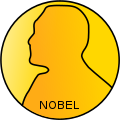约翰·M·马丁尼斯
| 约翰·马修·马丁尼斯 John M. Martinis | |
|---|---|
 2017年 | |
| 出生 | 1958年(66—67歲) |
| 母校 | 加州大學柏克萊分校(理学学士、博士) |
| 奖项 |
|
| 科学生涯 | |
| 论文 | Macroscopic quantum tunneling and energy-level quantization in the zero voltage state of the current-biased Josephson junction[1](1985) |
| 博士導師 | 约翰·克拉克[1] |
约翰·马修·马丁尼斯(英語:John Matthew Martinis,1958年—),美国量子物理学家,加州大學聖塔芭芭拉分校物理系教授。2014年,谷歌量子人工智能实验室宣布斥资数百万美元,聘请马丁尼斯团队使用超导量子比特建造量子计算机。
2025年,马丁尼斯与约翰·克拉克、米歇尔·H·德沃雷因发现电路中的宏观量子隧穿效应量子力学隧穿和能量量子化,获得诺贝尔物理学奖。
经历
[编辑]约翰·M·马丁尼斯1980年获得加州大學柏克萊分校理学学士学位,之后在该校攻读博士学位,研究宏观变量的量子行为,即约瑟夫森效应[4]。博士毕业后,马丁尼斯来到法国萨克雷,成为原子能委员会的第一位博士后。之后加入美国國家標準技術研究所的电磁技术部,研究超导量子干涉仪(SQUID)放大器[5]。任职研究所期间,开发出一种X射线检测的技术,该技术采用具有电热反馈的超导过渡边缘传感器微量热计[6]。
2002年起,一直致力于约瑟夫森结量子比特的研究,计划构建史上第一台量子计算机[7]。
2004年,担任加州大學聖塔芭芭拉分校沃斯特实验物理学讲席教授,至2017年卸任。2014年,谷歌量子人工智能实验室宣布斥资数百万美元,聘请马丁尼斯团队使用超导量子比特建造量子计算机[8]。
2019年10月23日,马丁尼斯团队在《自然》发表题为《使用可编程超导处理器实现量子计算优越性》("Quantum supremacy using a programmable superconducting processor")的论文[9],展示团队使用53量子比特的计算机首次实现量子计算优越性(从而推翻了扩展的邱奇-图灵论题)[10]。2020年4月,马蒂尼斯从谷歌离职,仅出任顾问[11][8]。
2020年,马丁尼斯移居澳大利亚,加入由约翰·西蒙斯教授的初创公司硅量子计算(Silicon Quantum Computing)[12]。
2021年,马丁尼斯获得约翰·斯图尔特·贝尔奖,以表彰其研究量子力学基本问题及其应用[3]。
2022年,基于“半导体行业能大规模制造高质量的量子比特,掌握着创造实用量子计算机的关键”,马丁尼斯于他人共同创办Qolab公司[13]。
2025年,马丁尼斯与与约翰·克拉克、米歇尔·H·德沃雷因发现电路中的宏观量子隧穿效应和能量量子化,获得诺贝尔物理学奖[14]。
参考资料
[编辑]- ^ 1.0 1.1 Physics Tree - John M. Martinis. academictree.org. [2020-04-21]. (原始内容存档于2025-01-22).
- ^ Fritz London Memorial Prize. phy.duke.edu. [2020-04-21]. (原始内容存档于2019-05-06).
- ^ 3.0 3.1 John Stewart Bell Prize. [2021-05-03]. (原始内容存档于2025-09-14).
- ^ Clarke, J.; Cleland, A. N.; Devoret, M. H.; Esteve, D.; Martinis, J. M. Quantum mechanics of a macroscopic variable: the phase difference of a josephson junction. Science. 1988-02-26, 239 (4843): 992–997. ISSN 0036-8075. PMID 17815701. S2CID 1732678. doi:10.1126/science.239.4843.992.
- ^ Welty, Richard P.; Martinis, John M. Two-stage integrated SQUID amplifier with series array output. IEEE Transactions on Applied Superconductivity. March 1993, 3: 2605–2608. ISSN 1051-8223. S2CID 33500389. doi:10.1109/77.233523.
- ^ Irwin, K. D.; Hilton, G. C.; Wollman, D. A.; Martinis, John M. X‐ray detection using a superconducting transition‐edge sensor microcalorimeter with electrothermal feedback. Applied Physics Letters. 1998-08-05, 69 (13): 1945. ISSN 0003-6951. doi:10.1063/1.117630.
- ^ Frederic Lardinois. Google Partners With UCSB To Build Quantum Processors For Artificial Intelligence. techcrunch.com. 2014-09-02 [2025-01-18]. (原始内容存档于2025-03-13).
- ^ 8.0 8.1 Google's Top Quantum Scientist Explains In Detail Why He Resigned. forbes.com. 2020-04-30 [2025-01-18]. (原始内容存档于2025-01-29).
- ^ Arute, Frank; Arya, Kunal; Babbush, Ryan; Bacon, Dave; Bardin, Joseph C.; Barends, Rami; Biswas, Rupak; Boixo, Sergio; Brandao, Fernando G. S. L.; Buell, David A.; Burkett, Brian. Quantum supremacy using a programmable superconducting processor. Nature. October 2019, 574 (7779): 505–510. ISSN 1476-4687. PMID 31645734. arXiv:1910.11333
 . doi:10.1038/s41586-019-1666-5
. doi:10.1038/s41586-019-1666-5  .
.
- ^ Shtetl-Optimized » Blog Archive » Quantum supremacy: the gloves are off. 2019-10-23 [2019-11-04]. (原始内容存档于2021-10-18).
- ^ Google's Head of Quantum Computing Hardware Resigns. Wired. [2020-04-21]. ISSN 1059-1028. (原始内容存档于2025-07-30) (英语).
- ^ Ex-Google quantum chief joins Simmons' silicon startup. InnovationAus. 2020-09-29 [2020-09-29]. (原始内容存档于2025-02-09) (美国英语).
- ^ About us. qolab.ai. [2025-01-18]. (原始内容存档于2025-04-21).
- ^ The Nobel Prize in Physics 2025. Nobel Foundation. [2025-10-07].

